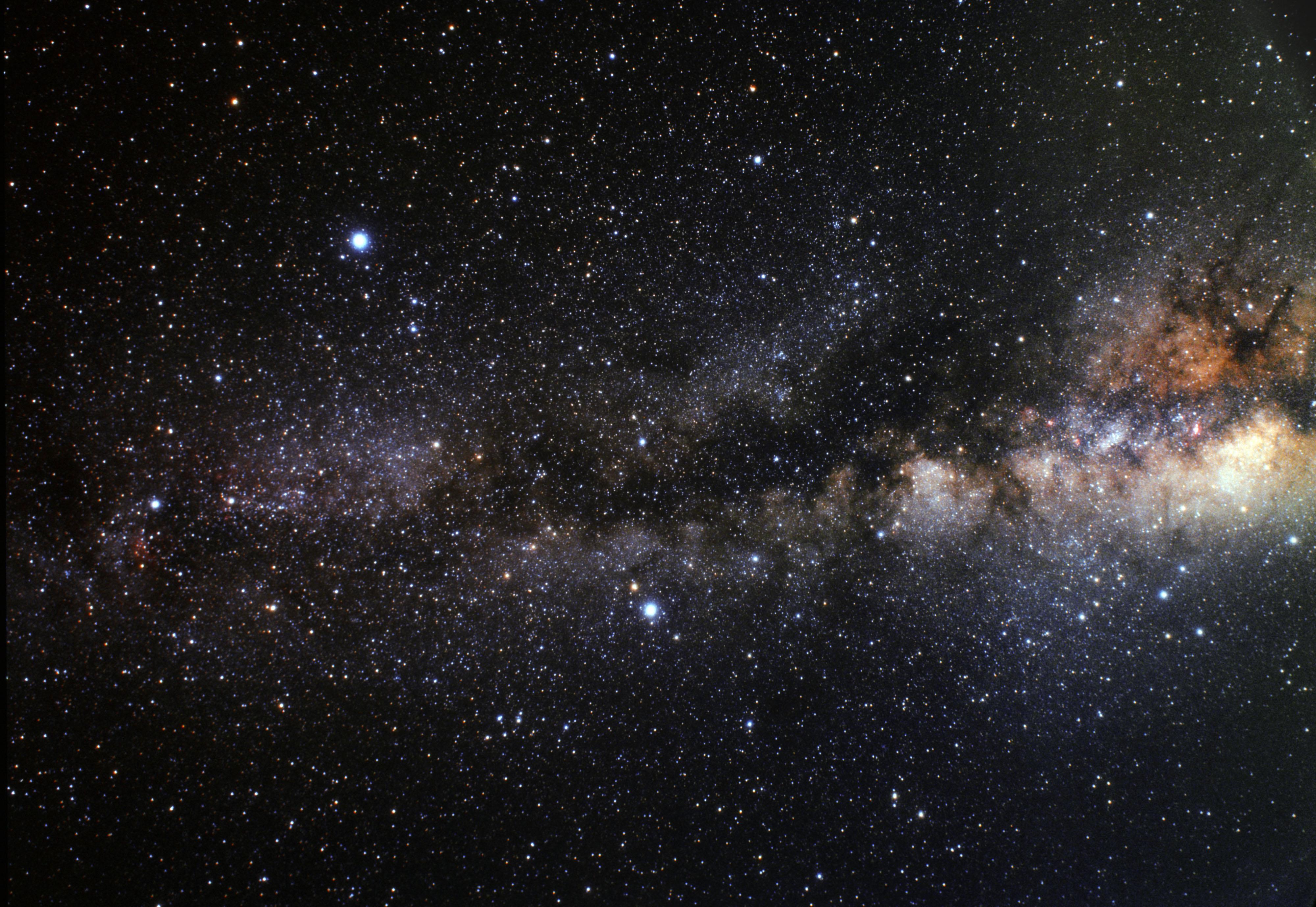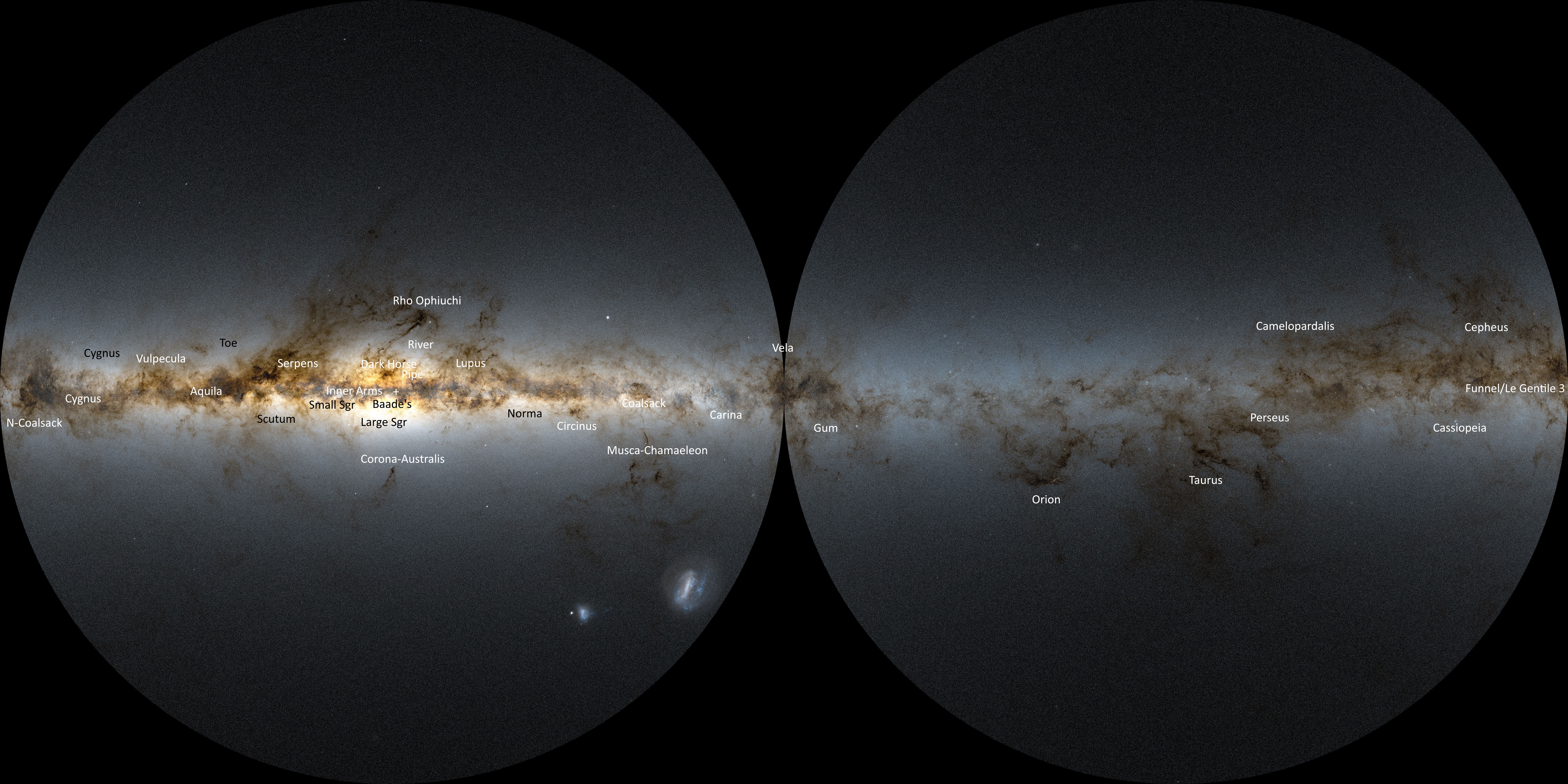Great Rift (astronomy) on:
[Wikipedia]
[Google]
[Amazon]
 In
In
 To the
To the  One of the regions obscured by the Great Rift is the Cygnus OB2 association, a
One of the regions obscured by the Great Rift is the Cygnus OB2 association, a
 Of this, Barnard said:
Of this, Barnard said:
Dark River, Wide Field
by Rogelio Bernal Andreo, at APOD Milky Way
 In
In astronomy
Astronomy is a natural science that studies celestial objects and the phenomena that occur in the cosmos. It uses mathematics, physics, and chemistry in order to explain their origin and their overall evolution. Objects of interest includ ...
, the Great Rift (sometimes called the Dark Rift or less commonly the Dark River) is a dark band caused by interstellar cloud
An interstellar cloud is an accumulation of gas, plasma, and cosmic dust in galaxies. Put differently, an interstellar cloud is a denser-than-average region of the interstellar medium, the matter and radiation that exists in the space between ...
s of cosmic dust
Cosmic dustalso called extraterrestrial dust, space dust, or star dustis dust that occurs in outer space or has fallen onto Earth. Most cosmic dust particles measure between a few molecules and , such as micrometeoroids (30 ÎĽm). Cosmic dust can ...
that significantly obscure ( extinguish) the center and most radial sectors of the Milky Way
The Milky Way or Milky Way Galaxy is the galaxy that includes the Solar System, with the name describing the #Appearance, galaxy's appearance from Earth: a hazy band of light seen in the night sky formed from stars in other arms of the galax ...
galaxy
A galaxy is a Physical system, system of stars, stellar remnants, interstellar medium, interstellar gas, cosmic dust, dust, and dark matter bound together by gravity. The word is derived from the Ancient Greek, Greek ' (), literally 'milky', ...
from Earth
Earth is the third planet from the Sun and the only astronomical object known to Planetary habitability, harbor life. This is enabled by Earth being an ocean world, the only one in the Solar System sustaining liquid surface water. Almost all ...
's perspective.
In dark, clear night skies
''Night Skies'' is an unproduced science fiction horror film that was in development in the late 1970s. Steven Spielberg conceived the idea after ''Close Encounters of the Third Kind''. Instead, material developed at the time was used in ''Pol ...
, the rift appears as clear as the bright bulge
__NOTOC__
Bulge may refer to:
Astronomy and geography
*Bulge (astronomy), a tightly packed group of stars at the center of a spiral galaxy
*Equatorial bulge, a bulge around the equator of a planet due to rotation
*Tharsis bulge, vast volcanic pla ...
of stars around the Galactic Center does to the naked eye
Naked eye, also called bare eye or unaided eye, is the practice of engaging in visual perception unaided by a magnification, magnifying, Optical telescope#Light-gathering power, light-collecting optical instrument, such as a telescope or microsc ...
or binoculars
Binoculars or field glasses are two refracting telescopes mounted side-by-side and aligned to point in the same direction, allowing the viewer to use both eyes (binocular vision) when viewing distant objects. Most binoculars are sized to be held ...
. The rift is largely between the Solar System
The Solar SystemCapitalization of the name varies. The International Astronomical Union, the authoritative body regarding astronomical nomenclature, specifies capitalizing the names of all individual astronomical objects but uses mixed "Sola ...
(which is close to the inner edge of the Orion Arm
The Orion Arm, also known as the Orion–Cygnus Arm, is a minor spiral arm within the Milky Way Galaxy spanning in width and extending roughly in length. This galactic structure encompasses the Solar System, including Earth. It is sometimes r ...
) and the next arm, inward, the Sagittarius Arm. The clouds are an obstruction to millions of the galaxy's stars detected at visible wavelengths, which compose a bright hazy band appearing 30° wide and arching through the night sky. The clouds within our radial sector of the galaxy span about from Earth. The clouds are estimated to contain about 1 million solar mass
The solar mass () is a frequently used unit of mass in astronomy, equal to approximately . It is approximately equal to the mass of the Sun. It is often used to indicate the masses of other stars, as well as stellar clusters, nebulae, galaxie ...
es of plasma and dust.
Properties
 To the
To the naked eye
Naked eye, also called bare eye or unaided eye, is the practice of engaging in visual perception unaided by a magnification, magnifying, Optical telescope#Light-gathering power, light-collecting optical instrument, such as a telescope or microsc ...
, the Great Rift appears as a dark lane that divides the bright band of the Milky Way
The Milky Way or Milky Way Galaxy is the galaxy that includes the Solar System, with the name describing the #Appearance, galaxy's appearance from Earth: a hazy band of light seen in the night sky formed from stars in other arms of the galax ...
vertically. The Great Rift covers one third of the Milky Way, and is flanked by strips of numerous stars, such as the ''Cygnus Star Cloud''. West of the ''Cepheus Clouds'', the ''Funnel cloud''/''Le Gentil 3'' and the bordering North America Nebula, the Great Rift starts with the Northern Coalsack at the constellation of Cygnus, where it is known as the Cygnus Rift. The Great Rift stretches from there over the Serpens-Aquila Rift; to Ophiuchus
Ophiuchus () is a large constellation straddling the celestial equator. Its name comes from the Ancient Greek (), meaning "serpent-bearer", and it is commonly represented as a man grasping a snake. The serpent is represented by the constellati ...
, where it broadens out; to Sagittarius, where it obscures the Galactic Center
The Galactic Center is the barycenter of the Milky Way and a corresponding point on the rotational axis of the galaxy. Its central massive object is a supermassive black hole of about 4 million solar masses, which is called Sagittarius A*, a ...
; essentially ending at Centaurus
Centaurus () is a bright constellation in the southern sky. One of the 88 modern constellations by area, largest constellations, Centaurus was included among the 48 constellations listed by the 2nd-century astronomer Ptolemy, and it remains one ...
.
 One of the regions obscured by the Great Rift is the Cygnus OB2 association, a
One of the regions obscured by the Great Rift is the Cygnus OB2 association, a cluster
may refer to:
Science and technology Astronomy
* Cluster (spacecraft), constellation of four European Space Agency spacecraft
* Cluster II (spacecraft), a European Space Agency mission to study the magnetosphere
* Asteroid cluster, a small ...
of young stars and one of the largest regions of star formation within 2 kiloparsecs. Similar dark rifts can be seen in many edge-on galaxies, such as NGC 891
NGC 891 (also known as Caldwell 23, the Silver Sliver Galaxy, and the Outer Limits Galaxy) is an edge-on unbarred spiral galaxy about 30 million light-years away in the constellation Andromeda. It was discovered by William Herschel on October 6, ...
in Andromeda and NGC 4565 (the Needle Galaxy) in Coma Berenices
Coma Berenices is an ancient asterism in the northern sky, which has been defined as one of the 88 modern constellations. It is in the direction of the fourth galactic quadrant, between Leo and Boötes, and it is visible in both hemispher ...
.
Human observation
left, Layout of some Great Rift "constellations" as represented by the Inca Dark zones obscuring the night-sky lighting mass of the bulk of the Milky Way in a dry atmosphere (or at long exposures) were recognized by many ancient civilizations in which a seasonally or regularly dry climate is a frequent feature. In South America, theInca
The Inca Empire, officially known as the Realm of the Four Parts (, ), was the largest empire in pre-Columbian America. The administrative, political, and military center of the empire was in the city of Cusco. The History of the Incas, Inca ...
gave some patterns of darkness and stars names much as normal stellar constellations were, including a series of animals like llama
The llama (; or ) (''Lama glama'') is a domesticated South American camelid, widely used as a List of meat animals, meat and pack animal by Inca empire, Andean cultures since the pre-Columbian era.
Llamas are social animals and live with ...
s, a fox
Foxes are small-to-medium-sized omnivorous mammals belonging to several genera of the family Canidae. They have a flattened skull; upright, triangular ears; a pointed, slightly upturned snout; and a long, bushy tail ("brush").
Twelve species ...
, toad
Toad (also known as a hoptoad) is a common name for certain frogs, especially of the family Bufonidae, that are characterized by dry, leathery skin, short legs, and large bumps covering the parotoid glands.
In popular culture (folk taxonomy ...
, and others, thought to be drinking from the "great river" (the Milky Way) and seen in silhouette.
The classical Greeks sometimes described the Great Rift as being the path of devastation left by Phaeton, who tried to guide the chariot of Helios
In ancient Greek religion and Greek mythology, mythology, Helios (; ; Homeric Greek: ) is the god who personification, personifies the Sun. His name is also Latinized as Helius, and he is often given the epithets Hyperion ("the one above") an ...
(the Sun god) across the sky before losing control, wreaking havoc, and finally being struck down by a lightning bolt of Zeus.
Modern astronomy first began to notice the rift in the 18th century, but struggled to explain it until E. E. Barnard and Max Wolf
Maximilian Franz Joseph Cornelius Wolf (21 June 1863 – 3 October 1932) was a German astronomer and a pioneer in the field of astrophotography. He was the chairman of astronomy at the University of Heidelberg and director of the Heidelberg-Kà ...
in the early 20th century, who produced the currently accepted explanation after careful photographic study.
 Of this, Barnard said:
Of this, Barnard said:
See also
*Coalsack Nebula
The Coalsack Nebula (Southern Coalsack, or simply ''the'' Coalsack) is a dark nebula, which is visible to the naked eye as a dark patch obscuring part of the Milky Way east of Acrux (Alpha Crucis) in the constellation of Crux (constellation), Cru ...
* Dark-cloud constellations
* Emu in the sky (a continuation from Scorpius to Crux)
* Large Sagittarius Star Cloud
* Serpens-Aquila Rift, a sub-feature of the Great Rift
* Small Sagittarius Star Cloud
References
Further reading
* * *{{cite web, url=http://stars.astro.illinois.edu/sow/mw.html, title=The Milky Way – From STARS, last=Kaler, first=Jim , work=University of Illinois at Urbana-Champaign, publisher=Department of Astronomy , pages=Maps 2 and 5, accessdate=2009-04-25Dark River, Wide Field
by Rogelio Bernal Andreo, at APOD Milky Way